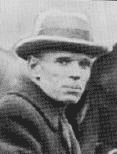Interesting
Football Stories– III
Football
Stories – I | Football
Stories – II |
Football Stories – IV
Football Stories – V | Football
Stories – VI | Football
Stories – VII
Craig James on Recruiting in His Day
Craig James was an outstanding RB at SMU from 1979-82, part of the "Pony Express" with Eric Dickerson that helped produced several Southwest Conference championships. James was the Texas high school Player of the Year his senior season when he set the 4A record with 2,411 yards. Needless to say, he was a highly sought player in an era when NCAA recruiting rules were not nearly as strict (or as rigorously enforced) as they are now.
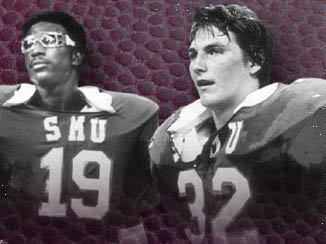 Eric Dickerson and Craig James Eric Dickerson and Craig James
Craig tells stories of his recruitment in his 2009 book Game Day: A Rollicking Journey to the Heart of College Football.
- First of all, he committed to SMU before his senior season for one simple reason: his girlfriend (and future wife) was enrolled as a freshman there. He never wavered from the commitment, although other coaches certainly tried to dissuade him.
- Since there were no limits on the number of contacts a coach could have with a high school player then, one unnamed coach would regularly appear at the Mexican restaurant where Craig and his football buddies (some of whom were also prospects) liked to eat. The coach would always take care of the check for them.
- One coach, described as "from the Midwest ... played in the NFL," promised him a condominium for his family, whom they would fly to all the games, and also $1,000 a month. "I was one wide-eyed eighteen-year-old!"
- He got hundreds of letters from schools. One day the postman delivered a big box to his house. It contained hundreds of letters from people at Arkansas. He also was bombarded by Western Union telegrams, some of them from Hollywood celebrities like Bob Hope and Aaron Spelling.
- James claims that, in that era, a "really good blue-chipper" could get "a car, an up-front cash payment of $50,000, and a monthly allowance of $1,000."
- A "pretty good player," one projected to letter four years, could receive "a little cash up front and a couple of hundred bucks a month."
James reserves his best stories for the one recruiter he does name, the biggest fisherman of all, Bear Bryant of Alabama. Since James' high school team ran the wishbone, Craig was perfect for Bear's offense.
- The first contact from Alabama came as he left the field following the AAAA state championship game, which his team won. Bear's RB coach introduced himself. James' reaction was "Wow!" Bryant later told Craig that he was skeptical about a white kid breaking the Texas rushing record and sent his assistants to see if he was for real.
- When James visited Tuscaloosa after a personal invitation from the Bear, he was greeted by his personal host and hostess, the latter one of Bear's Angels. He stayed in one of the guest rooms at the players' dorm. (No, the hostess didn't stay with him.) He remembers his exit interview with Bear in his smoke-filled office. ("Imagine that happening today!") Bear promised he'd be in touch.
- Two weeks later, Craig returned home to Houston from his weekend visit to his girlfriend at SMU. Waiting in the living room was the Angel from Tuscaloosa.
- Bear had decided that the only way he could get James was to convince his girlfriend to transfer to Alabama. So he recruited her hard too, promising to make her an Angel. He even called her parents asking them to help.
- Craig writes that "telling Coach Bryant I wasn't going to attend Alabama was very hard to do."
Concerning his recruitment and playing time at SMU, a school whose reputation was forever tarnished by the "Death Penalty" a few years later, Craig says:
I'm not going to sit here and tell you I never received a nickel during my playing days. But I can say with certainty that no benefits were ever extended to me from anyone associated with the SMU administration.
James believes his alma mater got a raw deal because "what was happening at SMU was happening all over the country."
|

Coach Bear Bryant
|
|
Who Put Those Goal Posts There?
The Washington Redskins
played the Cleveland Rams
in the 1945 NFL championship game on frozen field at Municipal Stadium
in Cleveland. In a scoreless game in the first quarter, Redskins
QB Sammy
Baugh threw a pass from his own end zone. However, a strong
gust of wind off Lake Erie blew the ball into the goalpost, which was
on the goal line in those days. The ball fell to the ground. Under the
rules, this was a safety. The two points proved to be critical in the
15-14 Rams victory. Less
than a month later, the Rams
got permission from the league to move to Los Angeles. Redskins
owner George
Preston Marshall was so mad at the outcome that he pushed
through a rule change for the next season: A forward pass that strikes
a goal post is automatically incomplete. This later became known as
the "Baugh/Marshall Rule."
|
First Title Didn't Last Long
In
1984 Florida won its first
football championship since joining the SEC as a charter member in 1933.
However, the Gators were
stripped of the title because of a record 106 recruiting violations by
Head Coach Charley Pell. Several weeks into the 1984
season, the school was placed on probation and banned from TV appearances
and bowl games for two years. Pell was fired immediately,
with Galen Hall taking over (and leading the team to
a title on the field only to have it stripped by the conference). Most
fans were outraged at Pell's shameless and embarrassing
conduct. However, a group of two dozen well-heeled Gator
boosters rewarded Charley with a $24,000 Lincoln Town
Car. One of those who contributed $1,000 was George Steinbrenner,
Yankee owner and proud
Florida
grad (MBA).
|
In
the first three years of the BCS, Kansas
State finished the regular season 3rd (1998), 6th (1999),
and 9th (2000). Yet the Wildcats
of Coach Bill Snyder did not go to a BCS bowl in any
of the three years.
- 1998:
they were upset in the Big 12 Championship Game by Texas
A&M, knocking them out of the BCS championship
game. 11-1 KSU went
to the Alamo Bowl where they were upset by unranked Purdue
37-34.
- 1999:
KSU was 10-1 but the
loss was to Nebraska,
which gave the 'Huskers
the Big 12 North championship. The Wildcats
defeated Washington
24-20 in the Holiday Bowl.
- 2000:
The 'Cats lost to
Oklahoma 27-24 in the Big 12 championship
game to finish the regular season 10-2. Still denied an at-large BCS
berth, they defeated Tennessee
35-21 in the Cotton Bowl.
They
were not the Big 12 champions in any of the three years and therefore
could not claim the automatic berth. Their weak non-conference schedule
and lack of a fan base that "travels well" were cited as factors
for not giving them an at-large berth.
KSU
finally made the Fiesta Bowl after the 2003 season because of their
shocking 35-7 upset of #1 Oklahoma
in the Big 12 championship game. They lost to Ohio
State 35-28 after QB Ell Robertson
was accused of sexual assault and cleared to play only at the last minute.
The 'Cats finished 11-4.
Oklahoma, meanwhile, survived
the defeat to play in the Sugar Bowl, losing the BCS championship to
LSU 21-14.
|
Have
you ever heard of Gil Dobie? Probably not. However,
he was one of the premier coaches of the early 20th century. (Don't
confuse him with Dobie Gillis.)
Minnesota-born
Dobie coached at the University
of Washington from 1908 through 1916. His record
during those nine seasons? 58-0-3. That's right.
He did not lose a game. Counting the last game of the 1907 season
(a 0-0 tie to Idaho under his predecessor) to
the first game of 1917 (under his successor), the Sun
Dodgers (they weren't the Huskies
until 1922) went 63 games without a loss. This is still a college
football record.
|
|
Within
the 63-game lossless streak was a 39-game winning streak which lasted
as #1 until Oklahoma broke
it in 1956. It is still the second highest all-time. Unlike the Sooners'
streak, UW's was spoiled
by a tie, 0-0 at Oregon State in 1914.
Dobie
left UW for Navy,
where he went 17-3 from 1917-19. He coached Cornell
to undefeated seasons in 1921, 1922, and 1923. Altogether, in his 33-year
career, he had 14 undefeated seasons.
In
1951, he became a charter member of the National
Football Hall of Fame. Unfortunately, Gil had died
in 1948.
|
|
Heisman and Final Four in Same Year
The only player to win the Heisman Trophy and play in the NCAA
basketball Final Four in the same year is Terry Baker
of Oregon State.
He
won the 1962 Heisman as the QB who led the Beavers
to a 9-2 season, including a 6-0 victory over Villanova
in the Liberty Bowl, then played in Philadephia.
In
March 1963, Terry started at guard for the
OSU cagers who won the West Regional,
defeating Seattle 70-66, San
Francisco 65-61, and Arizona
State 83-65. At the Final Four in Louisville,
the Beavers fell
to Cincinnati 80-46.
Terry played 27 minutes but went 0 for 9.
|
Baker was the #1 overall pick in the NFL draft by the
Los Angeles Rams but did
not fare well as a pro. The player who finished second to Baker
for the Heisman, Jerry Stovall of LSU,
had a good career as a DB for the St.
Louis Cardinals.
Reference:
Touchdown! Great Moments and Dubious Achievements in Football History,
John S. Snyder |
Not So Dynamic Debut
Pittsburgh
had not won a championship in the previous 35 years that the franchise
existed. A 1-13 finish in 1969 in Chuck Noll's
first year as coach earned the first
pick in the college draft after a coin toss with the equally
pathetic Bears.
The Steelers selected
a little-known QB from Louisiana
Tech named Terry Bradshaw. He
was immediately viewed as a savior by Steeler
fans. So a near-capacity crowd showed up on September 20, 1970,
for the first game ever at Three Rivers Stadium to watch his debut.
Before stepping on the field, Bradshaw threw
up. After watching his performance, that's what the fans wanted
to do. Wobbly passes. Missing wide-open receivers. Misfired on
nine straight passes and threw an interception that led to the
second Oiler TD.
Late in the 3rd quarter, Noll benched Terry
in favor of another Terry, Hanratty.
Bradshaw's line for his first game: 4 of 16 for
70 yards.
Afterwards,
the rookie said softly: "The toughest part was sitting out that
last quarter. I kept saying to myself, 'What now, big shot? Everybody
was counting on you, and you blew it. You better hide when you get to
that locker room.' But if you really believe in yourself, you've got
to take the good with the bad. If I don't shake this off, it'll stay
with me all week. And I've got to get ready for thirteen more games.
The coach has already told me that I'm his number one quarterback."
However, he started only seven more games in a miserable rookie season.
|
|
Reference:
The Football Hall of Shame, Bruce Nash and
Allan Zullo
|
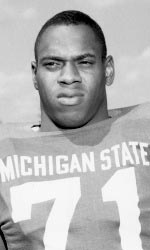
Charlie Thornhill
|
The Roanoke (VA) Touchdown Club made history after the 1962 football season when it presented its annual high school Most Valuable Back trophy to Charlie Thornhill. The powerful FB became the first African-American to win the award.
The guest speaker at that evening's banquet was impressed by Thornhill's accomplishments and demeanor. Coach Paul "Bear" Bryant put his arm around the young man's shoulders and asked: "Son, where you planning on going to school?"
Charlie replied that he had an offer from Notre Dame. Bear told him not to sign with anyone yet. But he didn't say this because he hoped to recruit the young man for Alabama. No, Bryant knew that his school and state were not ready for a black player. Instead, he called his good friend Duffy Daugherty at Michigan State to recommend Thornhill. Daugherty had turned MSU into a Big Ten power in part by recruiting black players from the South and other regions, players like DT Bubba Smith and WR Gene Washington, both from Texas, and QB Jimmy Raye from North Carolina.
Thornhill did sign with State, but his stay in East Lansing didn't start well. The culture clash between his Southern upbringing and life on a Northern campus came to the fore in an incident near the end of his freshman year. As RB coach Danny Boyster passed Charlie, he punched him in the chest and said, "How you doing, big boy?" Charlie responded, "Don't call me boy!" He realized later that Boyster had not intended the word "boy" in the demeaning way it was used in Virginia.
As a result of the incident, Thornhill was branded a troublemaker and moved to defense for his sophomore season. When the Spartans opened the 1964 season at North Carolina, Charlie's family went to the game only to find that he wasn't on the travel squad.
Charlie got back in the coaches' good graces the only way he could. Playing LB on the scout team, he made plays all over the field against the first team during a scrimmage. His nickname of "Mad Dog" changed from a putdown to an honor. Not only did he make the travel squad for the game at Wisconsin, but he began a streak of 25 straight starts.
In his last two years, Thornhill helped MSU amass a 19-1-1 record and win a Big Ten and a national championship. As a senior, he made first team All-Big Ten. He was drafted by the Boston Patriots, but his pro career was derailed by a series of injuries.
Reference: The Missing Ring: How Bear Bryant and the 1966 Alabama Crimson Tide Were Denied College Football's Most Elusive Prize, Keith Dunnavant
|
|
"This thing has alcohol in it!"
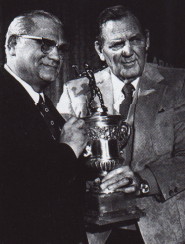
Woody Hayes and Bear Bryant holding
the 1978 Sugar Bowl trophy

Tony Nathan against Ohio State
1978 Sugar Bowl highlights video |
Woody Hayes' Ohio State Buckeyes came to New Orleans to play in their first Sugar Bowl following the 1977 season.
- The Buckeyes had finished 9-2, a strong season by anyone's standards. However, one of the losses was to archrival Michigan in the final game, 14-6. This defeat knocked OSU out of the Rose Bowl, where they had played for four straight years before defeating Colorado in the Orange Bowl, 27-10, after the '76 season.
- Hayes appointed assistant coach Gary Tranquill as the team's entertainment chairman for the Sugar Bowl. His job was to make sure the Buckeyes spent their non-practice time wisely.
- When the team arrived in the Big Easy, someone handed Tranquill a bunch of tickets for a free "hurricane" at the famous Pat O'Brien's bar in the French Quarter. Without really noticing what the tickets offered, Gary passed them out to the players and coaches.
- Naturally, many players made their way to Pat O'Brien's the first chance they got in order to use their coupons. Later, the Old Man himself, Coach Hayes, walked in and asked one of the players what was in the drink he was enjoying. Told it was like a fruit punch, Woody took a sip. "This thing has alcohol in it!" he yelled and threw the glass against the wall (or floor, depending on which witness you talk to).
- According to one version of the story, Woody ordered every player out of the establishment. Some hurriedly drank the rest of their hurricanes and poured out the ice so that they could keep the glass as a souvenir, as was (and still is) the New Orleans custom.
Partly because the 64-year-old Hayes was losing control of his ship and also because anything other than the Rose Bowl was considered a letdown, OSU got creamed by Bear Bryant's Crimson Tide 35-6, despite the fact that Woody desperately wanted to beat the Bear in his first (and only) meeting with him.
|
Reference: War As They Knew It: Woody Hayes, Bo Schembechler, and America in a Time of Unrest, Michael Rosenberg |
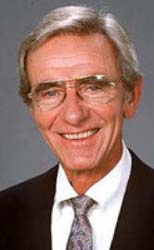
Chris Schenkel
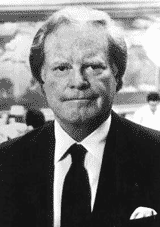
Roone Arledge

Keith Jackson
|
Concerned that the major football powers would secede and form their own organization, the NCAA reorganized itself into three divisions in 1973.
- Division I for the "major" schools
- Division II for smaller schools that gave athletic scholarships
- Division III for small colleges that did not offer scholarships
The NCAA governing body then creted championship playoffs in football for Divisions II and III.
Schools like Alabama, Notre Dame, Oklahoma, and USC were still not happy with the new arrangement.
- Division I included over 250 members.
-
Many DI schools played big-time basketball and other sports but did not play football on any level. For example, St. Louis U. and North Carolina-Charlotte.
- Others played football at a lower level. Example: St. John's
- As a result, schools that could not afford to play football with the big boys could vote on such matters as restricting football scholarships and the number of football coaches and a new television contract for football.
ABC had taken telecasting of college football to a whole new level.
- The NCAA football package with ABC generated $16M for the colleges in 1974. A school that played in a nationally-televised game received $487,000 while regional appearances netted $355,000.
- With the expiration of each successive tv contract, the NCAA relented on such restrictions as how many times a team could be on national tv in a season and how many games could be chosen later in the season when the contenders for conference and national championships were known.
One issue for many NCAA staffers and committee members was ABC's lead announcer, Chris Schenkel.
- While recognizing Chris's role in the development of tv broadcasts of both pro and college football, critics felt his laid-back style did not fit the excitement and passion that fans felt for the college game. One NCAA staffer wrote in a memo, "It's criminal to have this guy ho hum our best teams, our best games."
- One incident in particular had tarnished Schenkel's reputation. In the 1966 "Game of the Century" between Michigan State and Notre Dame, Chris did not question Ara Parseghian's strategy of playing for the tie in the last minutes.
- Roone Arledge, the head of ABC Sports, decided he had to make a change before the new NCAA contract took effect for the 1974 season. He would replace Schenkel with Keith Jackson, who had lost his job as play-by-play announcer for Monday Night Football after only one season when Arledge signed Frank Gifford when his CBS contract expired in 1971. Keith had become the lead announcer with Bill Russell on ABC's NBA telecasts. Starting in 1972, members of the print and electronic media voted Jackson voted Broadcaster of the Year five straight times.
- In the spring of 1974, Arledge went to Schenkel's apartment on Central Park South in New York and broke the bad news. "It was a colossal blow, right between my legs," recalled Schenkel. "But I've always respected Roone for one thing relating to that episode. At least he had the balls to come and tell me face to face." Chris became the voice of the Pro Bowlers Tour for many years.
- Jackson immediately infused college football broadcasts with unmistakable passion. As William Taafe wrote in Sports Illustrated in 1987, "The sound of Jackson's voice—energetic and crackling, always up and always on—was perfect for the rah-rah college game, and in a very short time, that sound became the sound of ABC Sports."
- Keith remained ABC's chief college football announcer through the 1998 season. He then broadcast regional games on the West Coast to cut down on travel from his home in British Columbia. Finally, he retired completely after doing the 2006 Rose Bowl between Texas and USC.
|
|
|
Craig James on Recruiting in His Day
Who Put Those Goal Posts There?
First Title Didn't Last Long
Three Top Tens, No BCS
58-0-3 in Nine Seasons
Heisman and Final Four in Same Year
Not So Dynamic Debut
Bear Recruits for MSU
"This thing has alcohol in it!"
Chris Has to Go
Football
Stories – I
Football
Stories – II
Football Stories – IV
Football
Stories – V
Football
Stories – VI
Football Stories – VII
Football Stories – VIII
Football
Stories – IX
Football
Stories – X
Football Magazine
Golden Rankings Home
Top of Page |
|
 Eric Dickerson and Craig James
Eric Dickerson and Craig James
